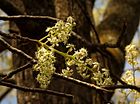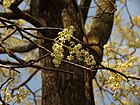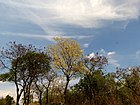Note: This is a project under development. The articles on this wiki are just being initiated and broadly incomplete. You can Help creating new pages.
Difference between revisions of "Chloroxylon swietenia"
(→Commonly seen growing in areas) |
(→References) |
||
| (7 intermediate revisions by the same user not shown) | |||
| Line 1: | Line 1: | ||
[[File:Chloroxylon swietenia 01.JPG|thumb|right]] | [[File:Chloroxylon swietenia 01.JPG|thumb|right]] | ||
| + | |||
'''Chloroxylon swietenia''' is a deciduous small to medium-sized tree growing up to 18 metres tall. It produces a decorative wood of excellent quality that fetches high prices on the international market. Because of its high quality timber, the tree has been greatly overexploited in the wild. | '''Chloroxylon swietenia''' is a deciduous small to medium-sized tree growing up to 18 metres tall. It produces a decorative wood of excellent quality that fetches high prices on the international market. Because of its high quality timber, the tree has been greatly overexploited in the wild. | ||
==Uses== | ==Uses== | ||
| Line 5: | Line 6: | ||
==Parts Used== | ==Parts Used== | ||
| − | {{Parts Used| | + | {{Parts Used|Leaves}}. |
==Chemical Composition== | ==Chemical Composition== | ||
| Line 11: | Line 12: | ||
==Common names== | ==Common names== | ||
| − | {{Common names|sa=|en=|gu=|hi=|kn=|ks=|ml=|mr=|pa=|ta=|te=}} | + | {{Common names|sa=Bimbilota|en=Satin wood|gu=|hi=Bhivia, Bhera|kn=Masula, Bittulla|ks=|ml=Varimaram|mr=Bheria, halda|pa=|ta=Porasu|te=Vaaimaram}} |
==Properties== | ==Properties== | ||
| Line 33: | Line 34: | ||
==Identification== | ==Identification== | ||
===Leaf=== | ===Leaf=== | ||
| − | {{Leaf|||}}<ref name="Leaf"/> | + | {{Leaf|Alternately arranged||15-22cm Long}}<ref name="Leaf"/> |
===Flower=== | ===Flower=== | ||
| − | {{Flower||||}} | + | {{Flower|Small|10-20cm Long|White|}} |
===Fruit=== | ===Fruit=== | ||
| Line 67: | Line 68: | ||
<references> | <references> | ||
| − | <ref name="chemical composition">[ | + | <ref name="chemical composition">[Chemistry]</ref> |
| − | <ref name="Leaf"> | + | <ref name="Leaf">Kappatagudda - A Repertoire of Medicianal Plants of Gadag by Yashpal Kshirasagar and Sonal Vrishni, Page No. 122</ref> |
<ref name="How to plant/cultivate">[http://tropical.theferns.info/viewtropical.php?id=Chloroxylon+swietenia Cultivation]</ref> | <ref name="How to plant/cultivate">[http://tropical.theferns.info/viewtropical.php?id=Chloroxylon+swietenia Cultivation]</ref> | ||
| − | + | ||
</references> | </references> | ||
==External Links== | ==External Links== | ||
| − | * [ ] | + | * [http://www.flowersofindia.net/catalog/slides/Ceylon%20Satinwood.html Chloroxylon swietenia on flowersofindia.net] |
| − | * [ ] | + | * [https://indiabiodiversity.org/species/show/31192 Chloroxylon swietenia on indiabiodiversity.org] |
| − | + | ||
[[Category:Herbs]] | [[Category:Herbs]] | ||
[[Category:Pages without herbs images]] | [[Category:Pages without herbs images]] | ||
Latest revision as of 11:15, 29 April 2021
Chloroxylon swietenia is a deciduous small to medium-sized tree growing up to 18 metres tall. It produces a decorative wood of excellent quality that fetches high prices on the international market. Because of its high quality timber, the tree has been greatly overexploited in the wild.
Contents
- 1 Uses
- 2 Parts Used
- 3 Chemical Composition
- 4 Common names
- 5 Properties
- 6 Habit
- 7 Identification
- 8 List of Ayurvedic medicine in which the herb is used
- 9 Where to get the saplings
- 10 Mode of Propagation
- 11 How to plant/cultivate
- 12 Commonly seen growing in areas
- 13 Photo Gallery
- 14 References
- 15 External Links
Uses
Snakebites, Wounds, Rheumatism, Headache, Impotence, Fever, Chest pain, Asthma, Painful joints, Bruises.
Parts Used
Chemical Composition
Common names
| Language | Common name |
|---|---|
| Kannada | Masula, Bittulla |
| Hindi | Bhivia, Bhera |
| Malayalam | Varimaram |
| Tamil | Porasu |
| Telugu | Vaaimaram |
| Marathi | Bheria, halda |
| Gujarathi | |
| Punjabi | |
| Kashmiri | |
| Sanskrit | Bimbilota |
| English | Satin wood |
Properties
Reference: Dravya - Substance, Rasa - Taste, Guna - Qualities, Veerya - Potency, Vipaka - Post-digesion effect, Karma - Pharmacological activity, Prabhava - Therepeutics.
Dravya
Rasa
Guna
Veerya
Vipaka
Karma
Prabhava
Habit
Identification
Leaf
| Kind | Shape | Feature |
|---|---|---|
| Alternately arranged | 15-22cm Long |
Flower
| Type | Size | Color and composition | Stamen | More information |
|---|---|---|---|---|
| Small | 10-20cm Long | White | {{{5}}} |
Fruit
| Type | Size | Mass | Appearance | Seeds | More information |
|---|---|---|---|---|---|
Other features
List of Ayurvedic medicine in which the herb is used
Where to get the saplings
Mode of Propagation
How to plant/cultivate
A plant of the lowland moist tropics, where it is found at elevations up to 450 metres.[3]
Commonly seen growing in areas
Dry deciduous forest on poor, Well drained sandy soils, Rocky soils.
Photo Gallery
References
- ↑ [Chemistry]
- ↑ Kappatagudda - A Repertoire of Medicianal Plants of Gadag by Yashpal Kshirasagar and Sonal Vrishni, Page No. 122
- ↑ Cultivation
External Links
- Ayurvedic Herbs known to be helpful to treat Snakebites
- Ayurvedic Herbs known to be helpful to treat Wounds
- Ayurvedic Herbs known to be helpful to treat Rheumatism
- Ayurvedic Herbs known to be helpful to treat Headache
- Ayurvedic Herbs known to be helpful to treat Impotence
- Ayurvedic Herbs known to be helpful to treat Fever
- Ayurvedic Herbs known to be helpful to treat Chest pain
- Ayurvedic Herbs known to be helpful to treat Asthma
- Ayurvedic Herbs known to be helpful to treat Painful joints
- Ayurvedic Herbs known to be helpful to treat Bruises
- Herbs with Leaves used in medicine
- Herbs with common name in Kannada
- Herbs with common name in Hindi
- Herbs with common name in Malayalam
- Herbs with common name in Tamil
- Herbs with common name in Telugu
- Herbs with common name in Marathi
- Herbs with common name in Sanskrit
- Herbs with common name in English
- Habit - Deciduous tree
- Index of Plants which can be propagated by Seeds
- Herbs that are commonly seen in the region of Dry deciduous forest on poor
- Herbs that are commonly seen in the region of Well drained sandy soils
- Herbs that are commonly seen in the region of Rocky soils
- Herbs
- Pages without herbs images




